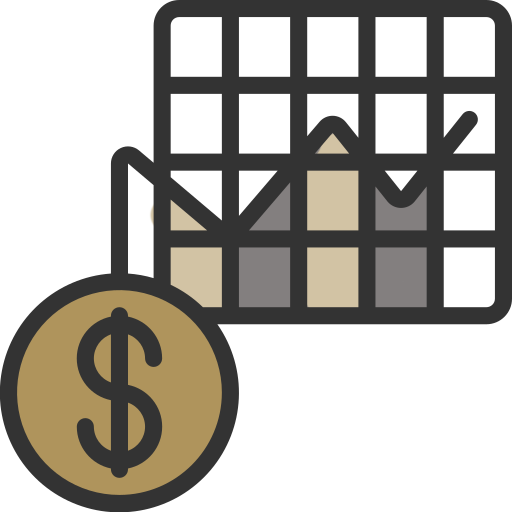Gold CFD Chart – XAU/USD
Gold CFD Charts: Understanding Gold CFDs
 In the often volatile world of gold trading, there’s an appealing option available for traders to use Contracts for Difference (CFDs) tied to gold. These types of financial derivatives enable participants to engage in speculation on the fluctuating prices of gold, while bypassing the need to buy and sell the physical asset.
In the often volatile world of gold trading, there’s an appealing option available for traders to use Contracts for Difference (CFDs) tied to gold. These types of financial derivatives enable participants to engage in speculation on the fluctuating prices of gold, while bypassing the need to buy and sell the physical asset.
This form of trading is increasingly favored among traders wishing to capitalize on the volatility of gold prices, whilst enjoying the ability to leverage their trades – essentially having more exposure to the market for less money down.
This double-edged sword can enhance and multiply profitable trades, but can also increase losses, making the trading of gold CFDs more suitable for experienced investors with a solid risk appetite.
Why Trade Gold CFDs?
Gold Contracts for Difference (CFDs) offer a unique approach to engaging with the gold market. They provide several benefits for experienced traders, while also highlighting the need for caution, particularly due to their leveraged nature.
- Significant Leverage: Gold CFDs are leveraged products, meaning they allow traders to amplify their market exposure with a relatively small capital outlay. However, this also magnifies potential losses, making risk management crucial.
- Opportunities in Market Fluctuations: CFDs enable traders to potentially profit from both rising and falling gold prices. This flexibility is a distinct advantage over traditional forms of gold investing.
- Portfolio Diversification: Adding gold CFDs to a trading portfolio can provide diversification due to gold’s often inverse relationship with other financial assets.
- High Liquidity: The gold CFD market offers high liquidity, facilitating efficient trade execution – something that’s key to short-term trading strategies.
- Reduced Transaction Costs: Trading costs, fees and spreads for gold CFDs can be significantly lower than those for physical gold, as they avoid storage, insurance, and other related expenses.
- Avoidance of Physical Ownership: CFDs bypass the logistical issues of storing and securing physical gold, focusing instead on price movements. This can be a good or bad thing depending on if you’re a gold bug!
- Broad Market Access: Many trading platforms offer gold CFDs, providing flexibility in terms of trading hours and market access.
- Advanced Risk Management Tools: Platforms offering gold CFDs often include risk management tools, essential for mitigating the heightened risks due to leverage.
As mentioned, owing to their complexity and sometimes highly leveraged nature, gold CFDs might not be suitable for beginners. New traders should approach with caution, ideally gaining experience and understanding of market dynamics before engaging.
Gold CFD companies like AvaTrade can set up training accounts specifically to help educate newer users on the risks involved, and can give users a risk-free sandbox filled with $50,000 imaginary dollars. Whilst this doesn’t 100% replicate the real feeling of trading due to risk having been completely removed, it quickly shows you if you have the mindset required to trade Gold CFDs.
How to Trade CFDs on Gold
![]() Getting started with Gold CFD trading is usually a straightforward process, irrespective of the broker you choose. Most trading platforms provide real-time gold quotes and a variety of tools to aid in trading. Here are the general steps to get started:
Getting started with Gold CFD trading is usually a straightforward process, irrespective of the broker you choose. Most trading platforms provide real-time gold quotes and a variety of tools to aid in trading. Here are the general steps to get started:
- Open an Account: Begin by registering for a trading account with your chosen broker. This typically involves providing some personal and financial information to meet regulatory requirements.
- Fund Your Account: To start trading, deposit funds into your account. The amount may vary depending on the broker’s requirements and your trading strategy.
- Select Gold CFD: Within your broker’s trading platform, navigate to the selection of available CFDs and choose Gold, often listed as ‘Gold’ or ‘XAU/USD.’
- Market Analysis: Utilize the charting and analytical tools provided by the platform to evaluate current market conditions. This involves studying trends, technical indicators, and potentially global economic factors that might influence gold prices. If this is new to you, we always recommend using the training account first!
- Execute Your Trade: Decide on your trading position – buying (going long) or selling (going short) on gold CFDs, based on your market analysis. Determine the size of your trade and set any risk management features like stop-loss or take-profit orders.
- Monitor Your Position: Stay updated with your open trade, ready to make adjustments or close the position in response to market movements or as part of your trading plan.
- Risk Management: Be sure to implement strategies like stop-loss orders and take-profit levels to manage your exposure and protect your investment. Risk management is one of the most important elements in trading Gold CFDs as trading without a sound approach can result in often significant losses.
Each broker may have specific features or steps, but these general guidelines are common across most platforms.It’s important to familiarize yourself with the specific tools and conditions of your chosen broker before trading with your own money as if you suddenly need to exit a position and don’t know how… well it’s not ideal is it?
Understanding the Size of Gold CFD Contracts
When it comes to trading Gold CFDs, contract sizes can vary depending on the broker and the platform used. Generally, the structure of contract sizes is designed to provide flexibility for traders with different risk tolerances and account sizes.
Here are some key points to understand about Gold CFD contract sizes:
- Minimum Trade Size: Typically, the smallest trade size for Gold CFDs starts at 1 troy ounce. This allows traders to participate in the gold market with a relatively small amount of capital.
- Standard Lot Sizes: On many platforms, a standard lot size for Gold CFDs might correspond to 100 troy ounces – however, this may vary among different brokers.
- Micro and Mini Lots: For those looking to trade smaller amounts, micro (0.01 lot) and mini (0.1 lot) lots are often available. These smaller lot sizes provide greater control over the size of trades, especially useful for risk management.
- Maximum Exposure Limits: Brokers may set limits on the maximum exposure a trader can have in Gold CFDs. These limits can range significantly, accommodating both small-scale traders and those seeking larger positions – and is designed to help ensure traders don’t risk more than any broker platform will allow.
- Platform Specifics: Different trading platforms might have their unique specifications regarding contract sizes and trading limits. It’s important for traders to refer to the detailed information provided on their chosen platform to understand the specifics.
It’s essential for Gold CFD traders to familiarize themselves with the contract sizes and specifications offered by their chosen broker and trading platform, as this knowledge is crucial for effective risk management and aligning trades with individual trading strategies and preferences.Gold CFDs and The United States
While Gold Contracts for Difference (CFDs) are a popular trading instrument in many parts of the world, they are notably unavailable to traders in the United States.
This distinction is primarily due to specific regulatory frameworks and market structures in the U.S. Here are the key reasons behind this unavailability:
- Regulatory Restrictions: In the United States, the regulatory environment governed by bodies like the Commodity Futures Trading Commission (CFTC) and the Securities and Exchange Commission (SEC) does not permit the trading of CFDs. These regulations are designed to provide a certain level of market transparency and investor protection, which are considered not as robust in CFD trading compared to traditional investment forms.
- Higher Risk and Leverage: CFDs are known for their high leverage, which can significantly amplify both gains and losses. This characteristic aligns with a higher risk profile that U.S. regulatory authorities aim to protect retail investors from, particularly those who may not have a full understanding of the risks involved in leveraged trading.
- Market Manipulation Concerns: The U.S. regulators also express concerns about the potential for market manipulation within the CFD market. Given that CFDs are over-the-counter (OTC) products and not traded on regulated exchanges, there is a perceived higher risk of unfair practices. For anyone even vaguely familiar with the rampant gold market spoofing performed by some of the world’s biggest traders, this is disingenuous at best.
- Investor Protection Measures: U.S. financial regulations are heavily focused on investor protection. The absence of CFD trading, including Gold CFDs, aligns with this approach, as CFDs are seen as complex financial products that might not be suitable for the general public. Guns however are fine.
- Alternatives in the U.S. Market: Instead of CFDs, U.S. investors looking to speculate on gold prices might turn to other financial instruments such as gold futures, gold ETFs (Exchange-Traded Funds), or gold stocks. These alternatives are regulated and offer different ways to gain exposure to gold price movements.
In summary, while Gold CFDs offer unique trading opportunities, they are not aligned with the regulatory and investor protection frameworks in place in the United States. Traders in the U.S. interested in the gold market may need to explore other investment vehicles that are compliant with local regulations.Elsewhere however, Gold CFDs provide an option that can be highly profitable in the hands of an experienced trader.
Gold CFD Chart Disclaimer
These Gold CFD chart prices are disseminated for information only and shall not be considered as guidance in any case. Bullion.Directory makes no representation or warranty regarding the correctness, accuracy, completeness or fitness of the above information, contents for any particular purpose, and shall not be responsible for errors and omissions of any kind.
Users/ Visitors have to take their own decisions based on their own independent enquiries, appraisals, judgement, wisdom and risks. Bullion.Directory and its affiliates, or its employees, directors, or agents shall not be liable for any damage, direct or indirect, loss or costs whatsoever arising due to use of or relying upon the gold CFD prices disseminated.








 Material provided on the Bullion.Directory website is strictly for informational purposes only. The content is developed from sources believed to be providing accurate information. No information on this website is intended as investment, tax or legal advice and must not be relied upon as such. Please consult legal or tax professionals for specific information regarding your individual situation. Precious metals carry risk and investors requiring advice should always consult a properly qualified advisor. Bullion.Directory, it's staff or affiliates do not accept any liability for loss, damages, or loss of profit resulting from readers investment decisions.
Material provided on the Bullion.Directory website is strictly for informational purposes only. The content is developed from sources believed to be providing accurate information. No information on this website is intended as investment, tax or legal advice and must not be relied upon as such. Please consult legal or tax professionals for specific information regarding your individual situation. Precious metals carry risk and investors requiring advice should always consult a properly qualified advisor. Bullion.Directory, it's staff or affiliates do not accept any liability for loss, damages, or loss of profit resulting from readers investment decisions.
